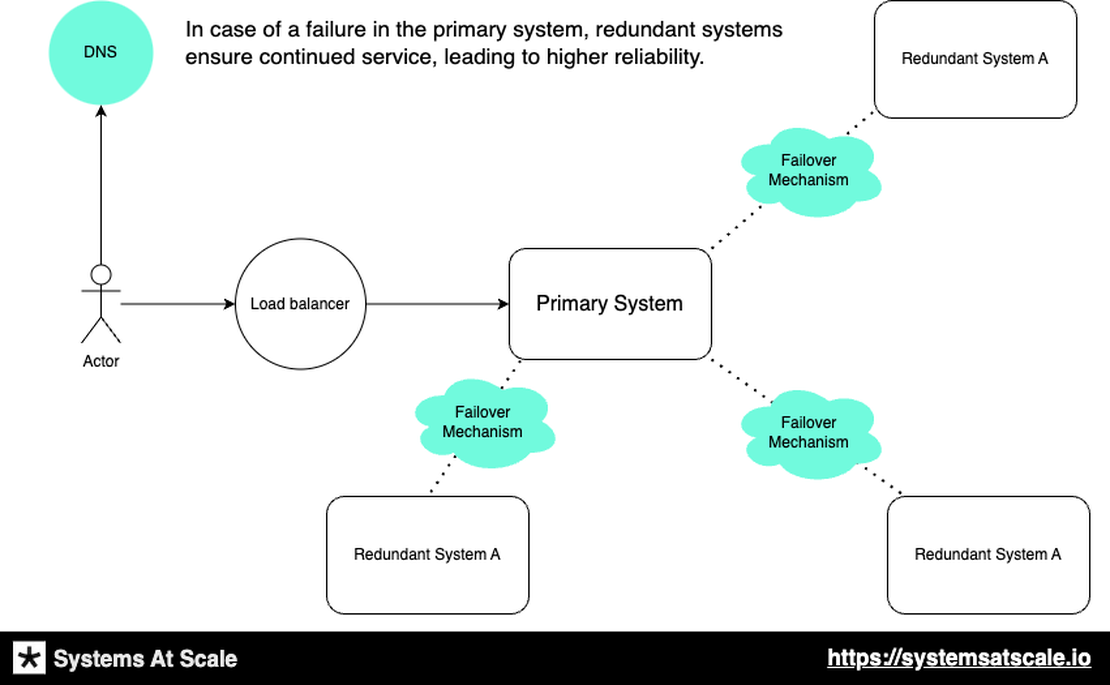Introduction
We often hear the saying
Don’t put all your eggs in one basket
In the ever-complex world of technology, how do you prepare your system to be resilient against unexpected failures? One word: redundancy. Whether it’s the human body’s design or the intricate systems of a jumbo jet, redundancy is nature’s and engineering’s way of ensuring continuity even when things go awry.
Understanding Redundancy
At its core, redundancy is the duplication of critical components or functions of a system to increase reliability. It’s a safeguard against failures. But don’t mistake redundancy for having a backup. While backups store data or capabilities for recovery after a failure, redundancy ensures no interruption, even during a failure.
Redundancy is the intentional duplication of system components, operations, or processes to increase the reliability and availability of the system, ensuring its continued functionality in the event of component failure.
Take Netflix, for example. Netflix developed a tool called Chaos Monkey , which randomly shuts down servers in their production environment. This ensures that their systems are resilient to failures. If a server goes down, the system can function without interruption.
Real-life Examples of Redundancy
Consider the human body. We have two kidneys, but we can function with just one. Aeroplanes, with their multiple engines, can often fly even if one engine fails. Modern buildings incorporate redundant escape routes and power sources, ensuring safety and functionality during emergencies.
Imagine the disaster if we had only one lung, one engine, or one escape route. Similarly, in the tech world, redundancy is a crucial component of any system that needs to be available 24/7.
Redundancy in Tech
While redundancy is vital in many aspects of life and engineering, its role is particularly crucial in technology. Here, redundancy ensures high system Availability , making it a cornerstone for any 24/7 service. It is a way to ensure that systems can continue functioning even when a component fails.
Types of Redundancy in Tech
As systems grow more complex, redundancy too evolves:
- Hardware redundancy: This involves having multiple physical components. For instance, dual CPU setups, multiple RAM modules, or dual power supplies.
- Software redundancy: Failover clusters or mirrored servers fall into this category. A secondary server can take over its operations if the primary server fails.
- Data redundancy: Distributed systems, like specific databases, store data across various nodes. If one node fails, data can be fetched from another.
- Network redundancy: Organizations often have contracts with multiple ISPs. If one’s services go down, the other ensures the organization remains online.
Benefits of Implementing Redundancy
The apparent benefit of redundancy is reliability. Systems that have redundancy built-in can guarantee higher uptime. Furthermore, redundancy can aid load balancing, distributing the operational strain and ensuring optimal performance. It’s also pivotal for disaster recovery, ensuring minimal service disruption during unforeseen incidents.
Best Practices for Redundancy in System Design
Implementing redundancy requires careful planning and monitoring to ensure it enhances reliability without adding unnecessary complexity or cost. Here are some best practices to consider:
-
Conduct a Risk Assessment Before implementing any redundant systems, assess the risks associated with potential failures. Identify critical components and functions that would have the most impact if they failed.
-
Prioritize Not every component may need redundancy. Prioritize based on the outcome of your risk assessment, considering factors like system criticality, downtime tolerance, and budget.
-
Opt for Modular Design Opt for a modular approach to system design whenever possible, allowing you to add or remove redundancy more easily. Modular systems can adapt to evolving requirements and technologies.
-
Implement Multi-Level Redundancy Do not rely solely on one type of redundancy. A multi-tiered approach combines hardware, software, data, and network redundancy to provide comprehensive failover protection.
-
Test Regularly Your redundant systems are only as reliable as their last successful test. Perform regular failover exercises to ensure the system behaves as expected during a failure.
-
Monitor Continuously Implement real-time monitoring to track the performance and status of both primary and redundant components. Automated alerts can help you address issues before they lead to system failures.
-
Perform Load Balancing Redundant systems often offer the benefit of load balancing. Distribute operational demands evenly to ensure no single component becomes a bottleneck, which can also serve as preventative maintenance.
-
Optimize for Quick Switch-over The duration it takes for your system to switch to the redundant component can be vital. Optimize your systems for quick failover to minimize service disruption.
-
Maintain and Update Technologies change, and what was once a state-of-the-art redundant system can quickly become outdated. Regular maintenance, including software updates, is essential.
-
Document and Train Maintain thorough documentation of the redundant systems, configurations, and failover procedures. Training the staff responsible for maintaining these systems can make a significant difference in effectively handling any unforeseen incidents.
Challenges and Potential Overheads
Redundancy has its challenges. Implementing redundant systems often comes with increased costs, not just in equipment but also in management. With added complexity, there’s also a need for specialized skills to maintain such systems. Additionally, redundant systems might lead to wasted resources if not correctly managed.
Summary
As we advance in this digital age, are your systems prepared to withstand unexpected failures? Implementing redundancy requires planning and introduces complexities, but the benefits often outweigh the costs. Investing in redundancy can be viewed as investing in both peace of mind and uninterrupted service.
- Redundancy can improve the reliability of systems by providing a backup in case of failure.
- It can also help improve systems’ availability by ensuring that they can continue to function even when some components fail.
- Redundancy can also help improve systems’ performance by distributing the load across multiple components.
- By carefully planning and implementing redundancy, system designers can create more reliable, available, and performant systems.
